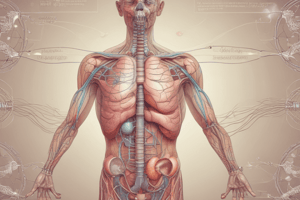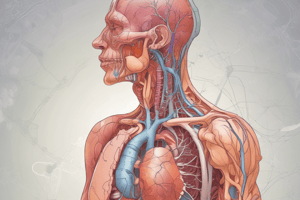Podcast
Questions and Answers
What is the volume of air remaining in the lungs even after a forcible expiration?
What is the volume of air remaining in the lungs even after a forcible expiration?
- 2000 mL to 2200 mL
- 1500 mL to 1600 mL
- 1100 mL to 1200 mL (correct)
- 900 mL to 1000 mL
What is the total volume of air a person can inspire after a normal expiration?
What is the total volume of air a person can inspire after a normal expiration?
- Expiratory Reserve Volume (ERV) only
- Tidal Volume (TV) + Inspiratory Reserve Volume (IRV) (correct)
- Tidal Volume (TV) only
- Inspiratory Reserve Volume (IRV) only
What is the primary site of exchange of gases?
What is the primary site of exchange of gases?
- Trachea
- Diaphragm
- Bronchi
- Alveoli (correct)
What is the mechanism by which O2 and CO2 are exchanged in the alveoli?
What is the mechanism by which O2 and CO2 are exchanged in the alveoli?
What is the maximum volume of air a person can breathe in after a forced expiration?
What is the maximum volume of air a person can breathe in after a forced expiration?
What is the total volume of air accommodated in the lungs at the end of a forced inspiration?
What is the total volume of air accommodated in the lungs at the end of a forced inspiration?
What is the approximate volume of air inspired or expired during a normal respiration?
What is the approximate volume of air inspired or expired during a normal respiration?
What happens to the intra-pulmonary pressure when the diaphragm and inter-costal muscles relax?
What happens to the intra-pulmonary pressure when the diaphragm and inter-costal muscles relax?
What is the average volume of air that a person can inspire by a forcible inspiration?
What is the average volume of air that a person can inspire by a forcible inspiration?
What is the purpose of a spirometer in clinical assessment?
What is the purpose of a spirometer in clinical assessment?
What is the average breathing rate of a healthy human?
What is the average breathing rate of a healthy human?
What is the average volume of air that a person can expire by a forcible expiration?
What is the average volume of air that a person can expire by a forcible expiration?
What is the primary function of the respiratory system?
What is the primary function of the respiratory system?
What happens during inspiration and expiration?
What happens during inspiration and expiration?
How do oxygen and carbon dioxide exchange occur in the alveoli and tissues?
How do oxygen and carbon dioxide exchange occur in the alveoli and tissues?
What is the purpose of a spirometer?
What is the purpose of a spirometer?
What is the result of long exposure to harmful substances in the lungs?
What is the result of long exposure to harmful substances in the lungs?
What is the byproduct of cellular respiration that is harmful?
What is the byproduct of cellular respiration that is harmful?
Flashcards are hidden until you start studying




